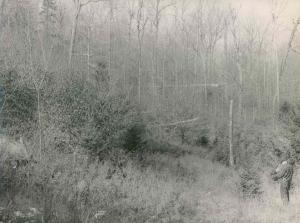| Collection: | Paul Smith Experimental Forest Historical Photo Archive |
| Keywords: |
selection post-harvest hardwood |
| Organisms: |
maple yellow birch white ash |
| Location: | Paul Smith Experimental Forest |
| Description: | With light selection cutting (residual stand 70 sq. ft. B.A.) existing understory beech were benefited, but few hard maple, white ash, and yellow birch seedlings grew more than 12 inches high. This is 17 years after the first cutting. "Does this happen only on less-fertile soils? Would hard maples have reacted like this on more-fertile soils? Maple seed trees were more abundant here than beech seed trees." |
| Date: | 1950 |
| Collection: | Paul Smith Experimental Forest Historical Photo Archive |
| Keywords: |
personnel selection post-harvest |
| Organisms: |
maple yellow birch white ash |
| Location: | Paul Smith Experimental Forest |
| Description: | Selection plot in background. Cut back to 70 sq. ft. basal area in 1938 and again in 1948. This was too much overstory for hard maple, yellow birch, and white ash seedlings. |
| Date: | 1950 |
| Collection: | Paul Smith Experimental Forest Historical Photo Archive |
| Keywords: |
personnel clearcut browse hardwood |
| Organisms: |
deer yellow birch white ash |
| Location: | Paul Smith Experimental Forest |
| Description: | Clearcut in 1937. Deer suppressed hardwoods until exclosure was put up 10 years later. With protection, white ash and yellow birch are growing; none this large are found outside the exclosure. |
| Date: | 1950 |
| Collection: | Paul Smith Experimental Forest Historical Photo Archive |
| Keywords: |
suppression hardwood |
| Organisms: |
maple beech yellow birch witch hobble white ash |
| Location: | Paul Smith Experimental Forest |
| Description: | Control plot. Under the dense hardwood overstory, few hard maple, yellow birch, or white ash seedlings developed beyond 12 inches high. Even the tolerant witch hobble and beech were much less abundant here than on the selection plot where they had more light. |
| Date: | 1950 |
| Collection: | Paul Smith Experimental Forest Historical Photo Archive |
| Keywords: |
personnel shelterwood browse |
| Organisms: |
deer maple yellow birch white ash beech witch hobble |
| Location: | Paul Smith Experimental Forest |
| Description: | The shelterwood plot was left with about 50 sq. ft. of basal area among overstory trees 6"+ d.b.h. This opening produced an abundance of hard maple, yellow birch, and white ash seedlings. Deer promptly came to "picnic" and have permitted few of these to grow beyond 12" high (snow provides some protection). Six years later these better hardwoods were growing well only within the protection of the deer exclosure. Severe browsing outside of it was benefiting the less-palatable beech and witch hobble. |
| Date: | 1950 |
| Collection: | Paul Smith Experimental Forest Historical Photo Archive |
| Keywords: |
personnel clearcut browse |
| Organisms: |
deer yellow birch white ash maple beech red spruce |
| Location: | Paul Smith Experimental Forest |
| Description: | Clearcut 18 years earlier, deer browsing has eliminated most yellow birch, white ash, and hard maple seedling. Less-palatable beech and red spruce continued to grow. |
| Date: | 1950 |






